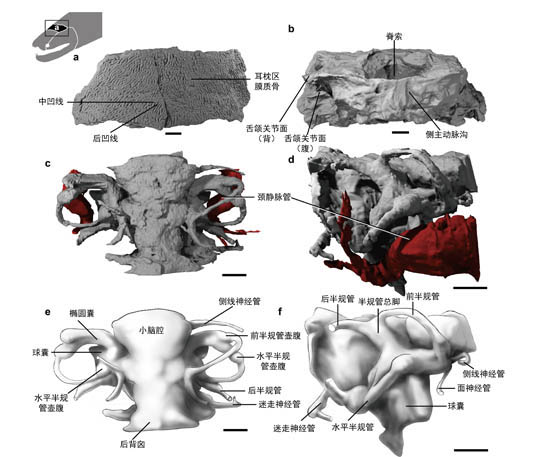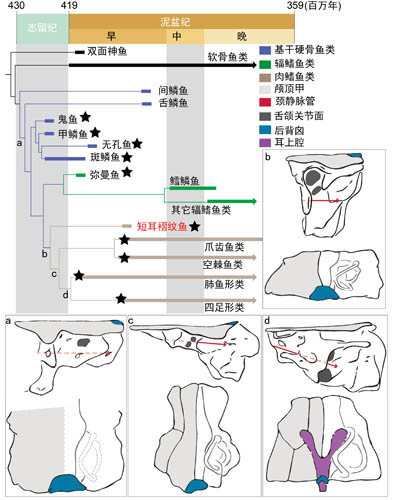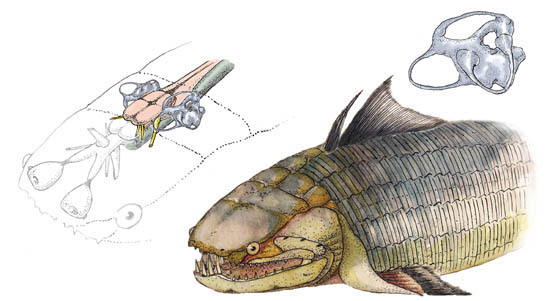Lu Jing and others from Zhu Min’s team at the Institute of Vertebrate Paleontology and Paleoanthropology, Chinese Academy of Sciences, together with scholars from the University of Oxford in the United Kingdom and the University of Michigan in the United States, have created a new basis for the Bragg Period of the Early Devonian in Zhaotong, Yunnan (about 410 million years ago). The brain fossils of the lobe-finned fish Ptyctolepis brachynotus gen. et sp. nov. were studied in detail, and complex and unexpected morphological characteristic information was extracted, showing that the grouper fish (Ptyctolepis brachynotus gen. et sp. nov. , anopunctate fish, and ghost fish) may be more primitive than previously thought, very close to the common ancestor of ray-finned fishes and lobe-finned fishes. The new research has advanced the academic community's understanding of the brain morphology of the earliest teleost fish to a considerable extent, and shaken the systematic relationship at the base of teleost evolution. The research results were published in the British magazine "Nature Communications" on December 5.
Bony fishes can be called the evolutionary backbone of vertebrates, and the two major branches under them, namely ray-finned fishes and lobe-finned fishes, conquered the waters and land of the earth respectively. Since the establishment of the discipline of paleontology, the exploration of the origin and evolution of bony fishes has never stopped. However, the bony fishes in traditional Devonian fossil sites such as Europe and North America have differentiated into large categories with completely different morphologies and many of their original characteristics have disappeared. This has brought great difficulties to trace the initial rise of bony fishes. difficulty.
Since the 1980s, the discovery and research of a series of primitive bony fish fossils from China has opened an exciting new chapter in the study of the origin of bony fishes. Among them, the discovery of Psarolepis and its close relatives, such as Achoania and Guiyu oneiros, is the most eye-catching. They have features that people never thought could be combined in one body. , for example, a typical lobe-finned fish is divided into two parts, the front and rear, with a movable skull; a mid-back bone fragment and spines similar to those of placoderm fish, etc. Although spotted fish were still classified as lobe-finned fishes before, so many obvious primitive features make researchers suspect that they are also likely to be more primitive bony fishes. In order to clarify this issue, cranial characteristics, which contain a large amount of important morphological information, are very important. However, early bony fish brain fossils are quite rare, especially the ossification level of the otoccipital region is very low and often cannot be preserved, so our understanding of this part of the structure is very limited.
The Posongchong Formation of the Early Devonian in Zhaotong, Yunnan has preserved a large number of fish and plant fossils, representing a vibrant aquatic "paradise" 410 million years ago. The early vertebrate research team of the Institute of Vertebrate Paleontology has been conducting field work in the Posongchong Formation for many years and has successively collected a number of important fish fossils, especially bony fish fossils. Several important genera and species have been published before, such as the earliest tetrapod fish Tungsenia paradoxa, the earliest coelacanth fish Eupoosteus yunnanensis, and the earliest claw-toothed fish Euphorosteus yunnanensis. fish (Qingmenodus yui), etc., demonstrating the great potential research value of the vertebrate fauna of the Posongchong Formation. In recent field work, the research team found another fossil of the ear-occipital region of a bony fish whose surface decoration is very similar to that of the Silurian Dream Ghost Fish. It was named Short Ear based on its wide and short outline and surface wrinkles. Frilled fish.
Lu Jing and others used micro-CT and computer three-dimensional reconstruction technologies independently developed by the Institute of Paleovertebral Research and the Institute of High Energy Physics to restore the internal structure of the fossil in detail and extract as much complex morphological information contained in it as possible. Focusing on the detailed anatomical comparison and combing of structural features and their three-dimensional positional relationships such as the posterior dorsal fontanel, tongue and mandibular articular surface, inner ear bony labyrinth, and supraotic cavity, this is also the first time in the academic world. Obtain detailed data on the craniocranial morphology of the otoccipital region of early teleost fishes. Research shows that the tongue and jaw joints of the short-eared fish are just in the transitional stage of the evolution of basal lobe-finned fishes to the crown group of more advanced lobe-finned fishes: although it has evolved two typical tongue-mandibular joints of advanced lobe-finned fishes surface, but the jugular vein tube still passes under the two articular surfaces rather than between them, retaining the pattern of primitive teleosts. At the same time, the rudimentary form of the supraauricular cavity (including the endolymphatic sac and the endolymphatic duct connected to it, which is responsible for absorbing endolymph into the cerebrospinal fluid), a structure unique to advanced lobe-finned fishes, began to appear in the short-eared fish.
On this basis, Lu Jing and others conducted a comprehensive re-analysis of the systematic relationships at the root of the entire teleost evolutionary tree. The results showed that the combination of cranial features of the short-eared fish had a significant impact on the theory of early teleost evolution. . The short-eared fish itself is currently the only basal lobe-finned fish. Its discovery pushes the spotted fish to the more primitive position of the basal bony fish, showing that the spotted fish is very close to the ray-finned fish and ray-finned fish. Common ancestor of lobe-finned fishes. The huge branch of bony fish originally started from a morphological basis similar to that of spotted fish, and in the next 400 million years, it differentiated into prosperous descendants occupying diverse ecological niches across the entire earth, and we humans are also among these descendants. One.
Original link: https://www.nature.com/articles/s41467-017-01801-z

Figure 1 Three-dimensional reconstructed model of the brain and cranial cavity of Brachyurinosaurus. a, dorsal view of the brain; b, ventral view of the brain; c-f, dorsal view of the cranial cavity (c; e, line drawing); right side view of the cranial cavity (d; f, line drawing) (Photo provided by Lu Jing)

Figure 2 A simplified evolutionary tree of teleost fishes, showing the evolution of the lingual and mandibular joints and the structure of the inner ear lymphatic ducts; star-shaped symbols indicate teleost fish fossils discovered in China (photo provided by Lu Jing)

Figure 3 Short-eared fish and its brain and inner ear structure restoration (illustrated by Kong Jiayi)

Figure 4 Life restoration of the short-eared fish (painted by Kong Jiayi)